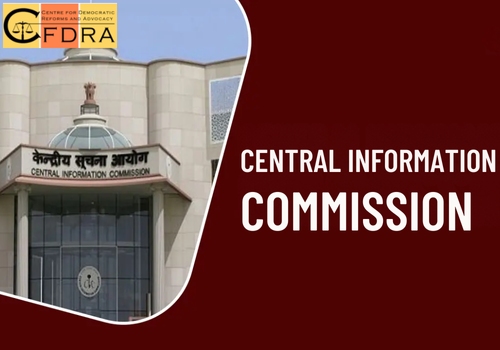Empowering the Central Information Commission: Supreme Court Upholds CIC’s Regulatory Authority

Introduction
In a significant ruling, the Supreme Court has affirmed the Central Information Commissioner’s (CIC) power to form benches and frame regulations for the effective management of the Central Information Commission under Section 12(4) of the Right to Information (RTI) Act, 2005. This decision overturns a previous Delhi High Court judgment that had challenged the CIC’s regulatory authority.
The Dispute: Challenging the CIC’s Regulatory Powers
The matter originated from an application filed by Sarbjeet Roy, seeking information about the modification of the Master Plan of Delhi for 2021 and requesting the Delhi Development Authority (DDA) to fulfill its obligations under Section 4 of the RTI Act. On September 22, 2009, the Central Information Commission ordered the formation of a committee to investigate the DDA’s compliance with Section 4 and submit a report. Aggrieved by this order, the DDA filed a writ petition before the Delhi High Court, challenging the summoning of its Vice-Chairman by the Central Information Commission.
The High Court’s Ruling: Curtailing the CIC’s Authority
The Delhi High Court expanded the scope of the case to examine the Central Information Commission’s authority under Section 12(4) of the RTI Act. Ultimately, the High Court quashed the Central Information Commission (Management) Regulations, 2007, on the grounds that the RTI Act did not explicitly provide legislative power to the Central Information Commission. The High Court held that the CIC lacked the power to delegate its inquiry responsibilities to a committee, exceeded its jurisdiction in framing the 2007 regulations, and did not have the authority to summon high-ranking officials like the DDA Vice-Chairman.
The Supreme Court’s Intervention: Restoring the CIC’s Regulatory Powers
The Central Information Commission appealed the High Court’s decision, and the matter reached the Supreme Court. The Supreme Court bench, comprising Justices Vikram Nath and Satish Chandra Sharma, set aside the High Court’s order, upholding the CIC’s authority to form benches and frame regulations for the effective management of the Commission.
Interpreting the RTI Act: A Purposive Approach
The Supreme Court adopted a broader interpretation of the RTI Act, emphasizing the necessity of efficient case disposal and effective implementation of the right to information. The court emphasized that the RTI Act must be interpreted purposively, considering its broader objectives of promoting transparency and accountability in public authorities.
The Scope of the CIC’s Regulatory Powers
The court held that Section 12(4) of the RTI Act grants the CIC the “general superintendence, direction, and management of the Commission’s affairs,” implying that the CIC has comprehensive authority to oversee and direct the functioning of the Commission. This broad section, the court said, allows the CIC to implement measures that ensure the smooth and efficient functioning of the Commission, including the formation of benches and the necessary decisions for its effective operation.
The Importance of Autonomy for Effective Functioning
The Supreme Court underscored the importance of the Commission’s autonomy for its effective functioning, stressing that undue interference in its administrative functions would impede its ability to handle a large volume of cases efficiently. The court emphasized that the CIC must be allowed to operate independently and exercise its powers of superintendence, direction, and management without external constraints.
Relying on Precedents: Lessons from the Election Commission
The Supreme Court relied on its previous judgments in Election Commission of India v. Ashok Kumar (2000) and Union of India v. Association for Democratic Reforms (2002), which highlighted the broad ambit of the words “superintendence, direction, and control” in the context of the powers of the Election Commission of India under Article 324 of the Constitution. The court drew parallels between the CIC and the Election Commission, emphasizing the need for administrative bodies to have the freedom to establish and implement internal procedures and regulations aligned with their specific mandates and operational requirements.
Upholding the CIC’s Regulatory Authority
The Supreme Court ultimately set aside the Delhi High Court’s judgment, upholding the CIC’s powers to frame regulations for the constitution of benches under Section 12(4) of the RTI Act. The court rejected the narrow interpretation of the RTI Act, stating that focusing solely on the nomenclature and the absence of an explicit provision for regulation-making would undermine the broader purpose and intent of the legislation.

Implications and Significance
The Supreme Court’s ruling is a significant victory for the Central Information Commission, as it reinforces the CIC’s autonomy and regulatory authority. This decision ensures that the CIC can effectively manage its affairs, including the formation of benches and the implementation of necessary administrative measures, to fulfill its mandate of ensuring transparency and accountability in public authorities.
The judgment also highlights the importance of interpreting legislation, such as the RTI Act, in a purposive manner, focusing on the broader objectives and the need for administrative bodies to have the necessary flexibility to operate efficiently. This ruling sets an important precedent for the interpretation of the powers and autonomy of other statutory bodies and commissions in India.
Conclusion
The Supreme Court’s ruling in the Central Information Commission case is a landmark decision that strengthens the CIC’s regulatory authority and underscores the importance of administrative autonomy for the effective functioning of statutory bodies. This judgment not only upholds the CIC’s powers but also serves as a guiding principle for the interpretation of the powers and independence of other commissions and authorities in India, ensuring that they can fulfill their mandates without undue interference.

